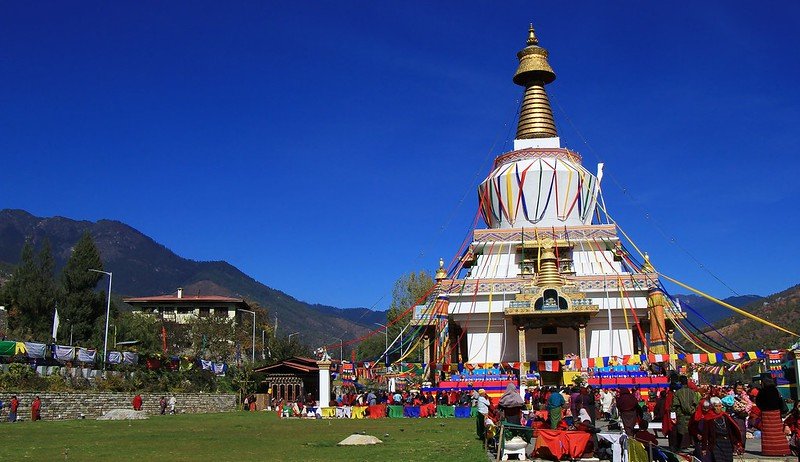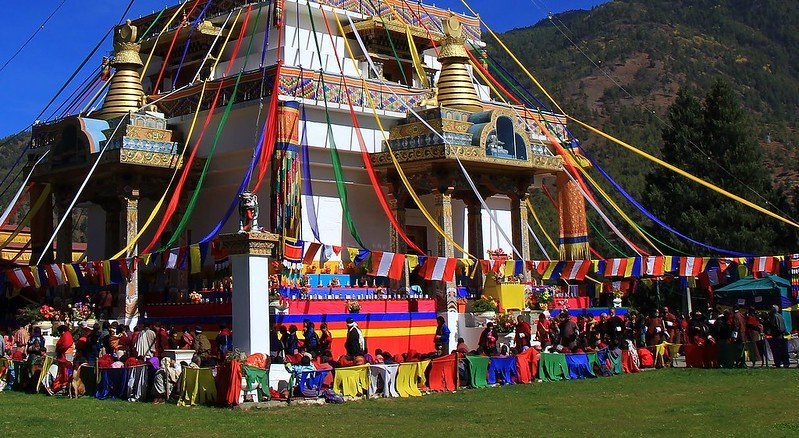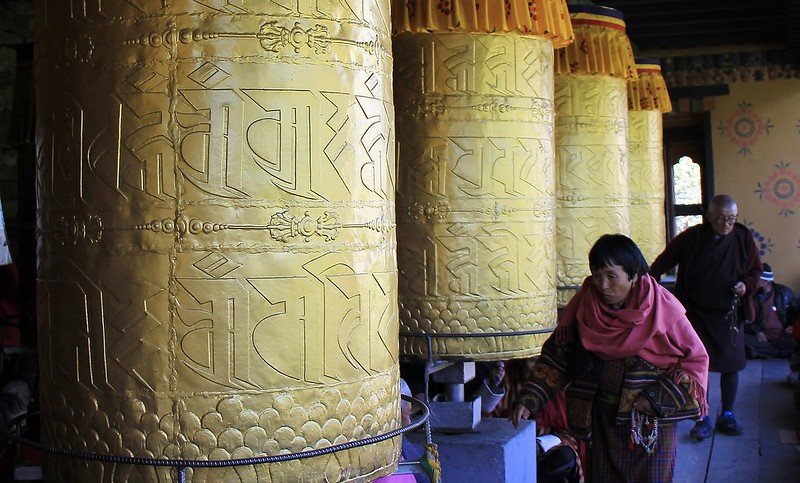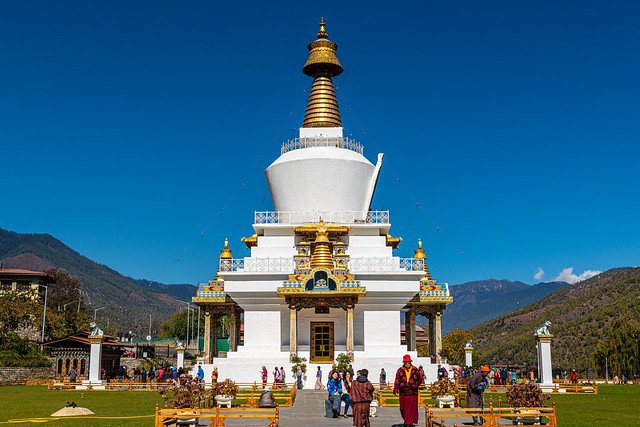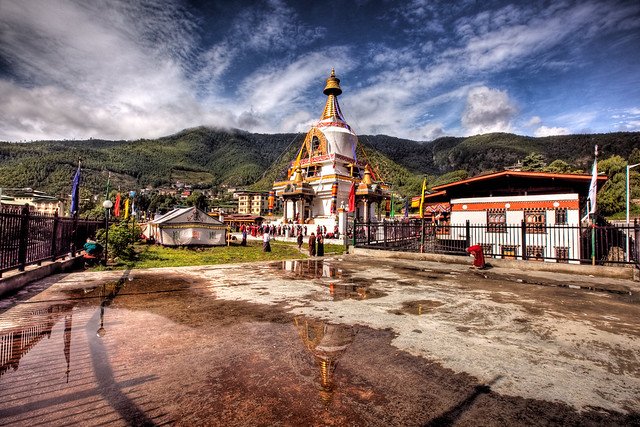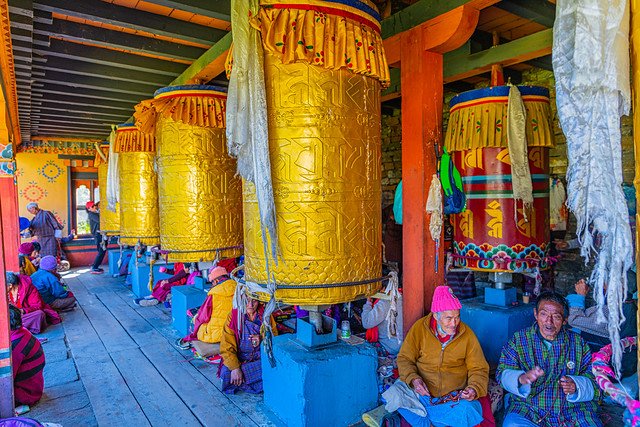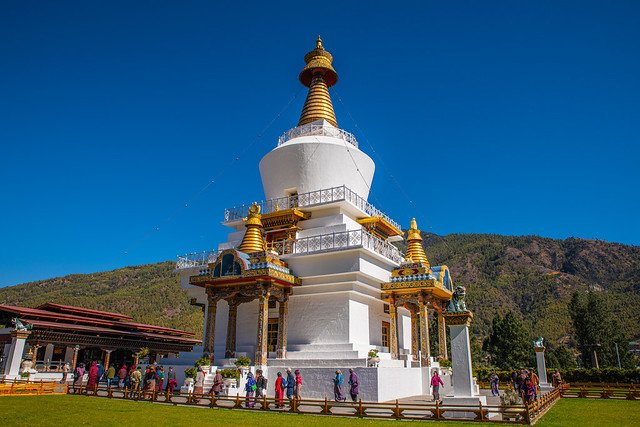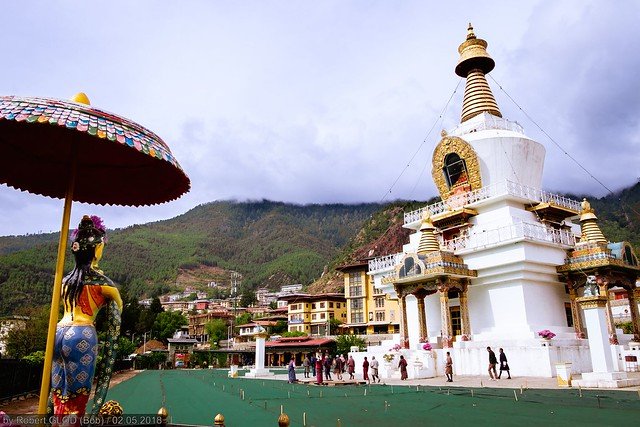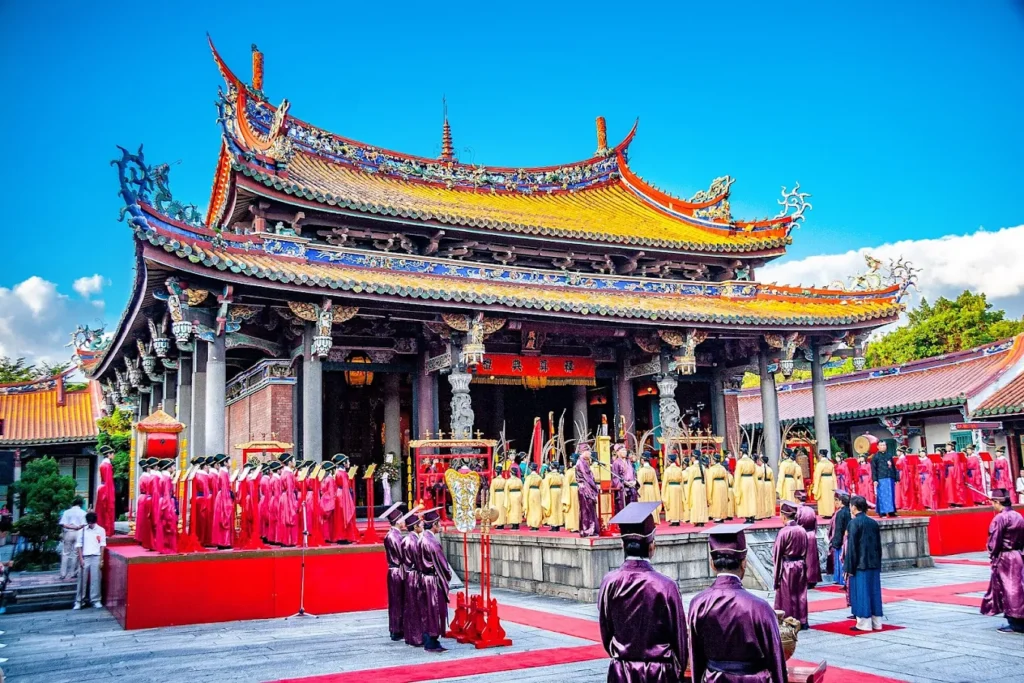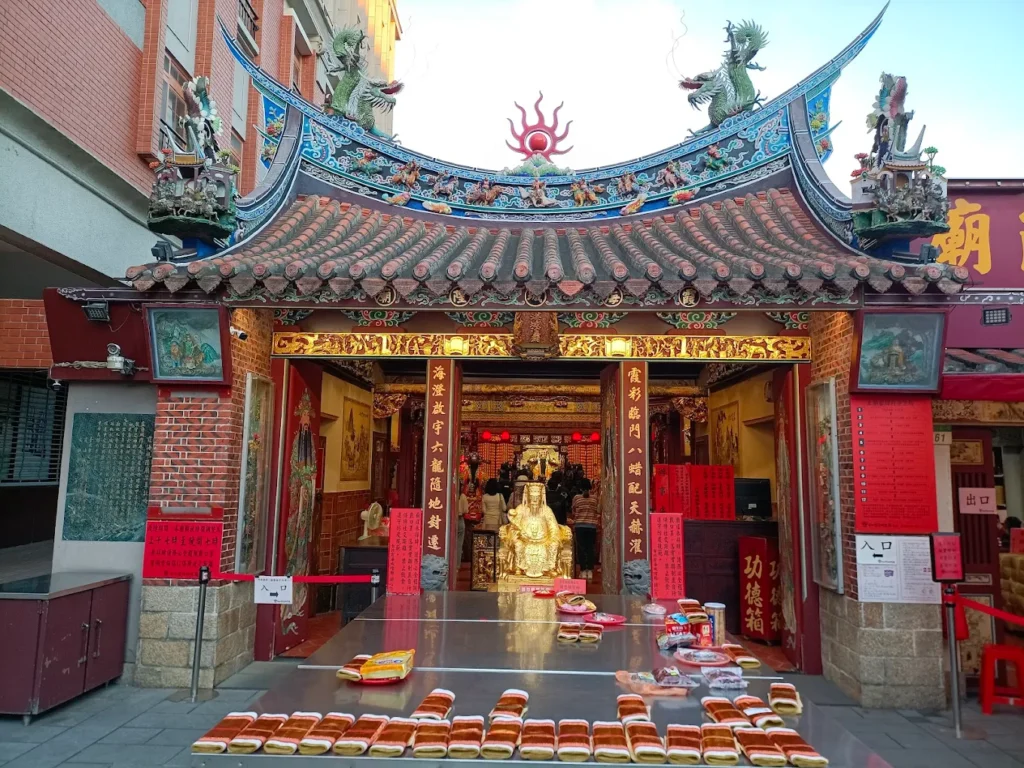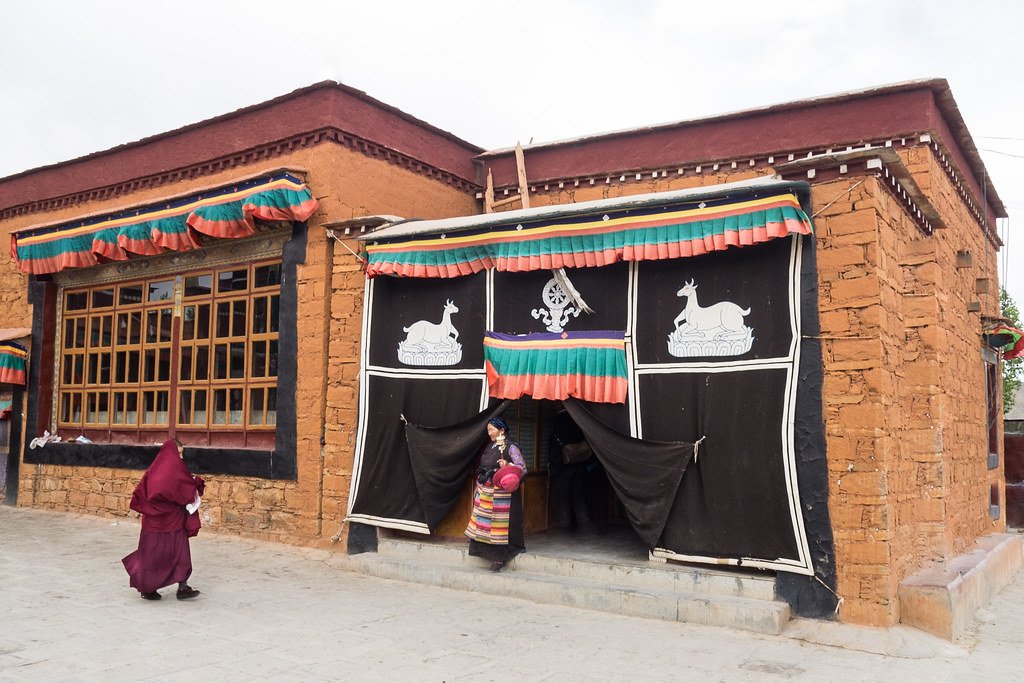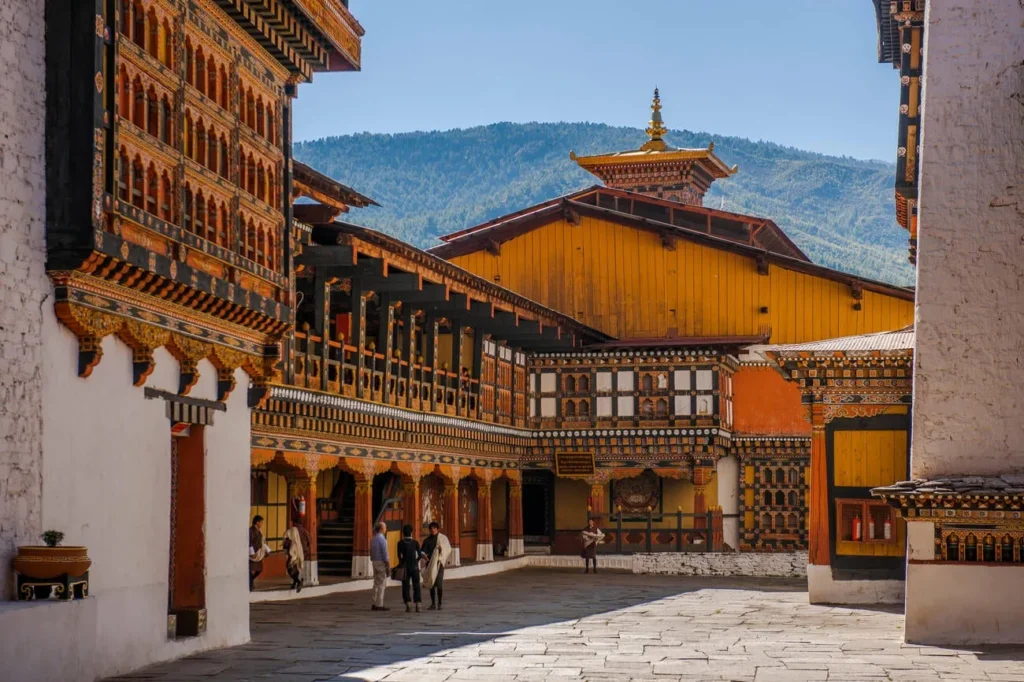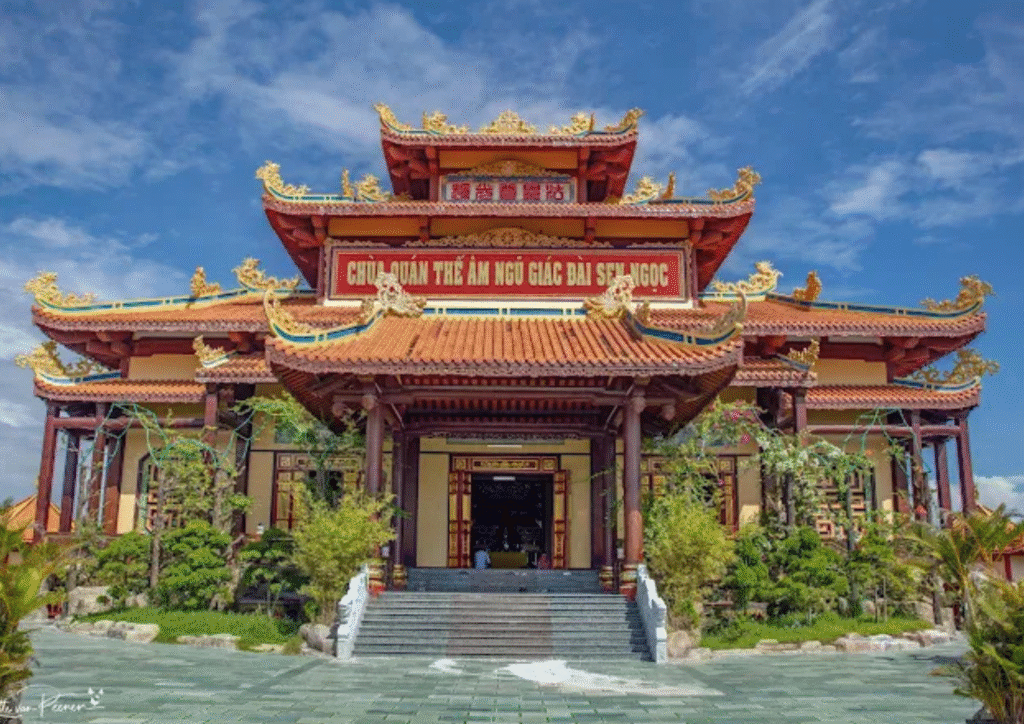National Memorial Chorten: Thimphu’s Eternal Flame of Peace
As twilight settles over Thimphu Valley, the National Memorial Chorten glows softly, its whitewashed stupa crowned with a golden crescent moon and sun. Built in 1974 to honor the Third Druk Gyalpo, Jigme Dorji Wangchuck (1928–1972), this sacred site hums with the steady rhythm of prayer wheels spun by elderly devotees and the scent of juniper incense wafting through the air. Known as Thimphu’s Chorten Lam, it embodies Bhutan’s Drukpa Kagyu and Nyingma traditions, with vibrant mandala halls and statues of wrathful deities guarding its inner sanctum. Crowds circumambulate the stupa, their murmurs blending with the distant clang of cymbals from nearby rituals. A symbol of peace and national unity, the chorten draws locals, pilgrims, and global travelers to its serene embrace, offering a glimpse into Bhutan’s spiritual heart amidst the capital’s urban pulse.
Beacon of Legacy: Overview and Significance
The National Memorial Chorten, located along Chorten Lam in Thimphu, stands as a monumental tribute to Bhutan’s modernization and spiritual heritage. Commissioned by Queen Mother Ashi Phuntsho Choden Wangchuck, it honors her son, the Third Druk Gyalpo, whose vision integrated Bhutan into the global community while preserving its Buddhist identity. A cultural and spiritual landmark, the chorten fosters unity and reverence.
Historical Roots and Legacy
Constructed in 1974, the chorten commemorates Jigme Dorji Wangchuck, who introduced democratic reforms, abolished serfdom, and established Bhutan’s first parliament. Designed by architect Thinley Norbu, the stupa reflects Tibetan-style chortens but adapts to Bhutanese aesthetics. Renovated in 2008, it remains a living monument, symbolizing the monarchy’s enduring bond with the people. Unlike traditional stupas housing relics, it serves as a memorial for peace, reflecting the king’s global advocacy for non-violence.
- Key Milestones:
- 1974: Chorten completed under royal patronage.
- 2008: Renovation enhanced structural integrity and artistry.
- Ongoing: Central to national ceremonies and daily devotion.
Cultural and Spiritual Significance
Rooted in Drukpa Kagyu and Nyingma traditions, the chorten is a spiritual hub where locals seek blessings through circumambulation and prayer. Its mandala halls, adorned with tantric deities, reflect Mahamudra [Great Seal], a Kagyu practice emphasizing the mind’s innate clarity through meditation. As a national symbol, it reinforces Bhutan’s Gross National Happiness philosophy, balancing material progress with spiritual well-being. Its prominence in Thimphu’s skyline draws global tourists, enhancing Bhutan’s cultural identity.
- Cultural Roles:
- Unites diverse Bhutanese communities through shared rituals.
- Promotes spiritual tourism, showcasing Vajrayana Buddhism.
- Embodies national pride, tied to the Wangchuck dynasty.
Community and Global Connections
The chorten is a daily gathering place for Thimphu’s residents, especially the elderly, who circumambulate to accumulate merit. It hosts national ceremonies, including royal commemorations, strengthening community ties. Internationally, it attracts visitors from Asia, Europe, and North America, who engage with monks and learn about Bhutanese Buddhism. Partnerships with organizations like the Bhutan Foundation support its upkeep and cultural programs, fostering global appreciation.
- Community Impact:
- Daily circumambulation fosters social bonds among locals.
- Educational talks by monks for tourists, ~30 minutes.
- Global recognition as a UNESCO tentative heritage site candidate.
As the chorten’s golden spire catches the fading light, its serene presence invites exploration of its architectural grandeur and spiritual depth, a testament to Bhutan’s enduring values.
Sanctuary of Enlightenment: Architectural and Spiritual Features
The National Memorial Chorten’s Tibetan-inspired design, adapted to Bhutanese aesthetics, blends functionality with profound symbolism. Built in 1974 and renovated in 2008, its stupa and mandala halls create a sacred space that harmonizes with Thimphu’s natural and urban landscape.
Iconic Design and Structures
The chorten’s square base, whitewashed dome, and golden spire follow the Jangchub Chorten model, symbolizing the path to enlightenment. Four mandala halls, one at each corner, house tantric deities, while a central shrine on the ground floor honors Jigme Dorji Wangchuck. Surrounding gardens with prayer wheels and benches enhance its tranquil ambiance. The 2008 renovation added vibrant frescoes and reinforced the structure, ensuring longevity.
- Design Highlights:
- Whitewashed stupa with golden crescent moon and sun.
- Four corner mandala halls, each with unique deity iconography.
- Landscaped gardens with 108 prayer wheels, a sacred number.
Sacred Statues and Relics
The central shrine features a portrait of Jigme Dorji Wangchuck, adorned with silks, alongside statues of Guru Rinpoche and Shabdrung Ngawang Namgyal, the unifier of Bhutan. The mandala halls house wrathful deities like Mahakala [Gonpo], a protector in Drukpa Kagyu, crafted in bronze with fierce expressions to ward off obstacles. The upper floor enshrines Phurba [ritual dagger] statues, symbolizing the subjugation of negativity. Vivid murals depict tantric cycles, guiding devotees through meditative visualization.
- Statue Details:
- Mahakala: Bronze, ~1.5 meters, with skull garland and flames.
- Guru Rinpoche: Gilded, central to Nyingma devotion, ~1 meter.
- Phurba Statues: Upper floor, symbolizing transformative energy.
Artistry and Environmental Harmony
Bhutanese artisans from the Zorig Chusum [13 traditional crafts] tradition crafted the chorten’s murals and carvings, using natural pigments and sustainable timber. The stupa’s white exterior contrasts with colorful mandalas, depicting deities and auspicious symbols like the Eight Lucky Signs. Its compact footprint and surrounding greenery align with Bhutan’s environmental ethos, minimizing disruption to Thimphu’s valley. The gardens, with seasonal flowers, foster a meditative atmosphere.
- Artistic Features:
- Mandala murals with mineral-based pigments, post-2008.
- Carved wooden beams with lotus and jewel motifs.
- Eco-friendly design, blending with Thimphu’s natural contours.
The chorten’s sacred artistry and serene setting prepare visitors for its vibrant rituals, where devotion and community converge in timeless practice.
Rhythms of Devotion: Rituals and Practices
The National Memorial Chorten pulses with daily and seasonal rituals, blending Drukpa Kagyu and Nyingma practices. These ceremonies, centered on peace and protection, draw devotees and visitors into Bhutan’s living spiritual tradition.
Daily and Unique Rituals
Each morning, monks chant sutras, such as the Mahakala mantra, to invoke protection, their voices resonating through the mandala halls. Devotees, especially elders, circumambulate the stupa, spinning prayer wheels to accumulate merit. A unique practice involves offering butter lamps before the Third Druk Gyalpo’s portrait, symbolizing gratitude and wisdom. These rituals, rooted in Mahamudra, emphasize mental clarity and compassion.
- Daily Practices:
- Morning sutra chants, ~1–2 hours.
- Circumambulation with prayer wheel spinning, open to all.
- Butter lamp offerings, ~100 lamps lit daily.
Festival Traditions
The chorten hosts major festivals, notably Drukpa Tshe Zhi (4th lunar month) and the King’s Birth Anniversary celebrations, honoring Jigme Dorji Wangchuck. During Drukpa Tshe Zhi, monks perform tshechu [sacred dances] and offer torma [ritual cakes], drawing thousands of locals. These events, distinct from daily rites, feature vibrant processions and communal prayers, with the stupa adorned in silk banners.
- Festival Highlights:
- Drukpa Tshe Zhi: 3-day tshechu with dances and offerings.
- King’s Birth Anniversary: National prayers and lamp lightings.
- Public participation, enhancing communal spirit.
Community and Visitor Engagement
Monks engage the community through prayers for peace and prosperity, while visitors are invited to join circumambulation or light butter lamps. Educational talks by monks explain Kagyu and Nyingma teachings, fostering cultural exchange. The chorten’s role as a communal space strengthens social bonds, particularly during festivals, when locals and tourists share in devotion.
- Engagement Activities:
- Guided circumambulation, ~20 minutes, for visitors.
- Talks on Mahamudra and Bhutanese Buddhism, daily.
- Community prayers during festivals, uniting diverse groups.
The chorten’s rituals, alive with devotion, pave the way for practical guidance, ensuring visitors can fully immerse themselves in its sacred ambiance.
Journey to the Chorten: Visitor Information
The National Memorial Chorten, centrally located in Thimphu, offers easy access for travelers seeking spiritual and cultural immersion. Its urban setting, clear etiquette, and nearby attractions make it a cornerstone of any Bhutanese itinerary.
Navigating the Chorten
Situated along Chorten Lam, the chorten is a 5–10-minute walk from Thimphu’s main town or a short taxi ride (~Nu 100). Follow Norzin Lam south, turning onto Chorten Lam, where the stupa’s golden spire is visible. The entrance, flanked by prayer wheels, leads to the main courtyard. Limited parking is available for private vehicles.
- Navigation Tips:
- Walk from Thimphu town via Norzin Lam to Chorten Lam.
- Look for the chorten’s spire near the Indian Embassy.
- Expect a 2-minute walk from parking to entrance.
Practical Details and Etiquette
The chorten is open daily from 6 AM to 6 PM, with no entry fee, though donations support maintenance. Visitors must dress modestly (long sleeves, no shorts), remove shoes before entering mandala halls, and avoid photography inside. Silence phones and refrain from pointing at statues. The full address is Chorten Lam, Thimphu 11001, Bhutan. Accessibility is moderate, with ramps but some steps at hall entrances.
- Logistics:
- Address: Chorten Lam, Thimphu 11001, Bhutan.
- Hours: 6 AM–6 PM, daily.
- Transport: Taxi (~Nu 100) or walk from town.
- Etiquette: Dress conservatively, no indoor photography, donate if possible.
Immersive Experiences and Surroundings
Visitors can light butter lamps (~Nu 20) or join circumambulation, spinning prayer wheels for merit. Engaging with monks during non-ritual hours offers insights into Kagyu practices. Nearby, the Weekend Market (10-minute walk) offers local crafts, while Changlingmethang Zangdok Pelri Temple (15-minute walk) provides further spiritual exploration. The Folk Heritage Museum (12-minute drive) showcases Bhutanese culture.
- Immersive Tips:
- Light a butter lamp for peace and gratitude.
- Join morning circumambulation for a meditative experience.
- Visit the Weekend Market and Folk Heritage Museum nearby.
The chorten’s accessibility and cultural richness invite deeper exploration of its philosophical and symbolic significance, connecting visitors to Bhutan’s spiritual core.
Wisdom of the Chorten: Cultural and Spiritual Insights
The National Memorial Chorten offers profound insights into Bhutanese Buddhism, weaving philosophical depth with national symbolism. Its role as a communal and environmental beacon underscores its enduring relevance.
Philosophical Foundations
The chorten’s Drukpa Kagyu practices emphasize Mahamudra, a meditative path to realize the mind’s luminous nature, free from delusion. This teaching, accessible through monk-led talks, encourages compassion and mindfulness, aligning with Bhutan’s Gross National Happiness ethos. Nyingma elements, like Guru Rinpoche’s presence, add tantric depth, emphasizing liberation through awareness.
- Key Concepts:
- Mahamudra: Non-conceptual meditation for mental clarity.
- Compassion: Embodied in circumambulation and lamp offerings.
Cultural and Symbolic Depth
The chorten’s stupa symbolizes the Buddha’s mind, its tiers representing the path to enlightenment. Mandala hall deities, like Mahakala, signify protection and transformation, guiding devotees through tantric visualization. The golden spire, a national emblem, reflects the monarchy’s role in fostering unity, explained during visitor interactions.
- Symbolic Elements:
- Stupa: Symbol of enlightenment and stability.
- Mandala Deities: Visual aids for tantric meditation.
Community and Environmental Resilience
The chorten unites Thimphu’s residents through daily rituals and festivals, fostering social cohesion. Its eco-conscious design, with minimal land use and native plants, reflects Bhutan’s environmental policies. Community programs, supported by the Bhutan Foundation, engage youth in Buddhist values, ensuring cultural continuity amidst urbanization.
- Resilience Efforts:
- Communal prayers, strengthening social bonds.
- Sustainable landscaping, preserving Thimphu’s ecology.
The chorten’s teachings and symbols resonate with universal themes of peace and harmony, inviting visitors to experience its transformative power.
Why You Have to Get to National Memorial Chorten
The National Memorial Chorten is a must-visit for its serene majesty and profound connection to Bhutan’s soul. Centrally located in Thimphu, its white stupa and golden spire embody the Third Druk Gyalpo’s legacy of peace and progress. Vibrant mandala halls, wrathful deities, and daily circumambulation by devoted locals offer an immersive glimpse into Drukpa Kagyu and Nyingma traditions. Its role as a national symbol, uniting communities and inspiring global pilgrims, underscores its timeless appeal. As prayer wheels spin and butter lamps flicker, the chorten beckons travelers, seekers, and researchers to Thimphu’s heart, where Bhutan’s past and present converge in a radiant celebration of unity and devotion.
